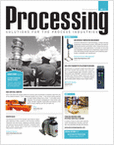Display problem ? Click HERE
Recommended :
Subscribe FREE - Processing Magazine
 A free surface vortex potentially form when :
A free surface vortex potentially form when :i) liquid exit via a nozzle or hole below it liquid surface (bottom or side) and
ii) liquid height (between liquid surface and nozzle/hole) is below a minimum submergence height (S).
When free surface vortex is formed, gas entrainment will occur and pull vapor / gas above liquid surface exit together with liquid via the nozzle / hole. The following image shows series of events taken place when a free surface vortex is formed.
Similarly, gas entrainment occurs at pump suction intake point causes vapor/gas enter pump reduce pumping capacity and vibration (due to pump impeller imbalance).
Submergence (S) is defined as the height between liquid surface and the exit hole. Following images show submergence (S) for different intake location and nozzle type.
Submergence subjects to intake velocity with the following relationship :
where
d = intake diameter (m)
Q = intake flowrate (m3/s)
Example :
A pump transferring liquid from a suction tank to a reactor at a rate of 227.1m3/h. The pump suction inlet nozzle with a internal diameter of 304.9mm is located horizontally. What is the minimum submergence to avoid gas entrainment ?
d = intake diamter = 304.9 /1000 = 0.3049 m
Q = intake flowrate = 227.1 / 3600 m3/h = 0.063 m3/s
S = 0.3049 + 2.3 (4 / SQRT(9.81) x PI) (0.063 / 0.3049)
S = 0.66 m
Thus, minimum submergence (S) is 0.66 m above intake nozzle.
* SQRT = Square-root
** PI = 3.141592654
Related Topic
- Estimate Pump Power Consumption without Vendor Information
- Trim Centrifugal Pump Impeller for Reduced Head
- Quick Check if Pump Performance Curve (Water) is Good for High Viscosity Fluid
- Quick Check if NPSHa is Sufficient Using Thoma Cavitation Curve
- Quick Pump Selection...
- Estimate Pump Efficiency base on Specific Speed (Ns)
- Pump Efficiency Estimation Without Vendor Information
No comments:
Post a Comment